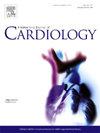Effectiveness of rate-adaptive pacing on patients with chronotropic incompetence: Systematic review and meta-analysis of randomized controlled trials
IF 3.2
2区 医学
Q2 CARDIAC & CARDIOVASCULAR SYSTEMS
引用次数: 0
Abstract
Background
Rate-adaptive pacing (RAP) complements heart rate (HR) responses in patients with cardiac pacing devices and chronotropic incompetence, although improvements in exercise capacity have varied across reported studies. The purpose of this study was to evaluate the effectiveness of the RAP mode across different clinical settings.
Methods
A systematic review and meta-analysis were conducted according to PRISMA guidelines. MEDLINE and EMBASE databases were searched through May 2024. Randomized controlled trials comparing RAP-on with RAP-off modes in patients with chronotropic incompetence were included. Outcomes related to exercise capacity, such as peak oxygen uptake (VO2), exercise duration, and patient-reported outcomes (PROs), were analyzed.
Results
Twelve trials with a total of 1199 patients were included. The meta-analysis showed that RAP-on significantly improved peak VO2 (mean difference [MD]: 1.35 ml/kg/min, 95 % confidence interval [CI]: 0.47 to 2.23) and exercise duration (MD:0.74 min, 95 % CI: 0.14 to 1.33) with augmenting peak HR (MD: 19 bpm, 95 % CI: 13 to 26) during cardiopulmonary exercise tests. The effectiveness of RAP on exercise capacity blunted particularly in patients with heart failure (HF) (MD: 0.36 ml/kg/min, 95 % CI: −0.88 to 1.60) compared with those without HF (MD: 1.95 ml/kg/min, 95 % CI: 0.66 to 3.23). PROs showed no significant improvement with RAP-on except for one study including non-HF.
Conclusions
RAP-on mode significantly enhances exercise capacity in patients with chronotropic incompetence, however, the benefits are less pronounced in patients with concomitant HF. In patient with HF, careful assessment is crucial to identify potential need for advanced therapeutic approach following the RAP-on pacing.

求助全文
约1分钟内获得全文
求助全文
来源期刊

International journal of cardiology
医学-心血管系统
CiteScore
6.80
自引率
5.70%
发文量
758
审稿时长
44 days
期刊介绍:
The International Journal of Cardiology is devoted to cardiology in the broadest sense. Both basic research and clinical papers can be submitted. The journal serves the interest of both practicing clinicians and researchers.
In addition to original papers, we are launching a range of new manuscript types, including Consensus and Position Papers, Systematic Reviews, Meta-analyses, and Short communications. Case reports are no longer acceptable. Controversial techniques, issues on health policy and social medicine are discussed and serve as useful tools for encouraging debate.
 求助内容:
求助内容: 应助结果提醒方式:
应助结果提醒方式:


